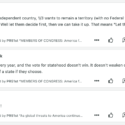Puerto Rico is a territory of the United States. Right now there are two bills on Puerto Rico’s political status being considered in Congress: HR 1522, the Statehood Admission Bill, and HR 2070, the misleadingly named Self-Determination Bill.
The name is misleading because it supports the common misperception that Puerto Rico hasn’t decided on a choice of status.
The comments shown in the screenshot at the top this post show that many people are misinformed about Puerto Rico’s status votes. One commenter claims that the people of Puerto Rico are evenly divided among the three viable status options (see below). Another says that Puerto Rico holds a status vote each year and statehood never wins; in fact, there have been three status votes in the current century, and statehood has won the vote each time. The third commenter says, “They have a Choice!” and it is true — but the choice has already been made.
Puerto Rico has three status options
Under the U.S. constitution, Puerto Rico has three options:
- statehood
- independence
- continued territory status
There is a myth, that Puerto Rico an the United States will someday come up with some special alternative to these three options, something that isn’t a state, a country, or a territory. This is a fantasy.
The Department of Justice has said “the only constitutionally permissible status options available…are statehood, independence, or Puerto Rico’s current status as a territory.”
Rep. Nydia Velazquez said, “We hold the pen.” In other words, as a Member of Congress, she ca make laws. This is true. However, Congress cannot sidestep the Constitution.
Puerto Rico has chosen statehood
Puerto Rico has held six status votes over the past half century.
- In 1967, the “commonwealth” option received 60.4%.
- In 1993, the “commonwealth” option received 48.6% of the votes, while statehood received 46.3%.
- In 1998, “None of the above” received 50.3% of the votes; statehood received 46.5%.
- In 2012, 54% voted against continuing as a territory; 61% voted for statehood.
- In 2017, 97% voted for statehood.
- In 2020, 53% voted for statehood.
Independence never received more than 5% of the vote. “Commonwealth” and “none of the above” are equally clearly not one of the three viable options. Statehood received a clear majority in each of the three most recent votes.
Commonwealth party sleight of hand
The “commonwealth” party has managed to sow enough confusion about these votes to allow Congress not to take action.
As long as Congress can say, “They can’t make up their minds, so what can we do?”, they can avoid having to take action.
Many legislators support statehood for Puerto Rico. We appreciate their support.
But there are others who worry that Puerto Rico voters will not support their party, or that their constituents in their states won’t be happy if they support statehood for Puerto Rico. Since they represent their party and their constituents, what is best for Puerto Rico may not be top of mind for them.
If you live in a state, please tell your legislators that you want statehood for Puerto Rico. And help spread the facts about statehood for Puerto Rico: it is the only path to equality for the Island. Let’s reduce the ignorance and help our fellow citizens understand the reality of Puerto Rico’s status.








No responses yet